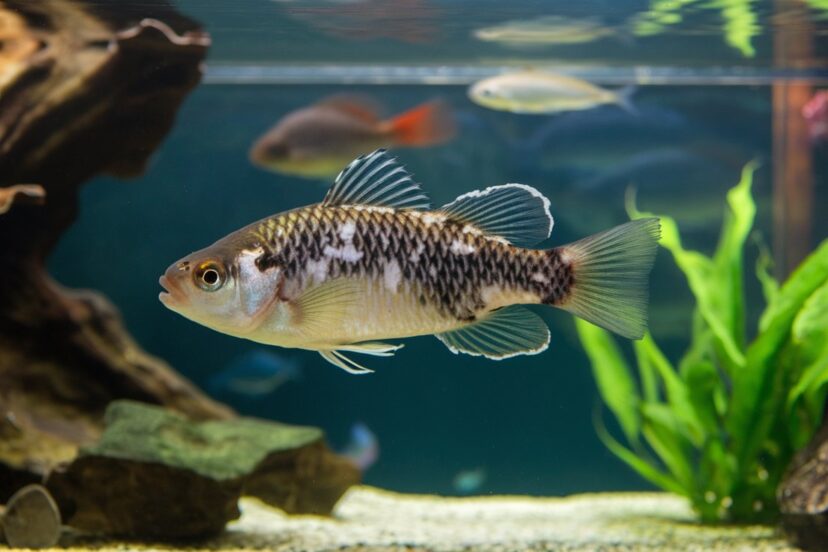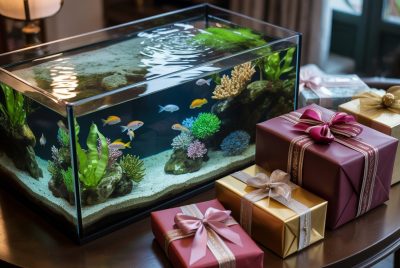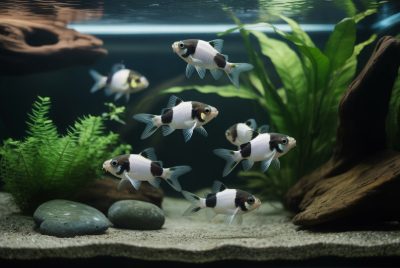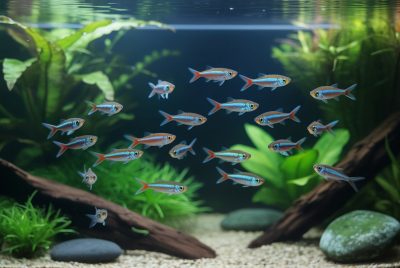Common Fish Diseases and How to Prevent Them
*We may earn a commission for purchases made using our links. Please see our disclosure to learn more.
The gentle ripple of water, the vibrant flash of colors darting beneath the surface, there’s something undeniably calming about maintaining an aquarium. As someone who has spent over a decade nurturing underwater ecosystems in my home, I’ve experienced firsthand the joy that comes from watching healthy fish thrive. But I’ve also encountered the heartbreak of discovering white spots spreading across my prized angelfish or watching a betta’s once-magnificent fins disintegrate seemingly overnight.
Fish keeping isn’t just about creating a beautiful display; it’s about creating a thriving ecosystem where living creatures can flourish. Unfortunately, even the most attentive aquarists will likely face fish diseases outbreaks at some point. Whether you’re maintaining a small desktop tank or an elaborate 100-gallon setup, understanding common fish diseases and implementing preventative measures is crucial for keeping your underwater friends happy and healthy.
In this comprehensive guide, I’ll walk you through the most common fish diseases that might afflict your aquatic companions, share my personal experiences battling these conditions, and provide practical, proven strategies to prevent disease before it strikes. Because when it comes to fish health, prevention isn’t just easier than treatment—it’s infinitely more humane.
Key Takeaways
- Early detection is critical—observe your fish daily for behavioral and physical changes
- Water quality is the foundation of disease prevention—maintain proper parameters and testing schedule
- Quarantine all new fish for at least 2-3 weeks before introducing them to your main tank
- Stress reduction significantly decreases disease susceptibility in fish
- Proper nutrition strengthens fish immune systems and resistance to pathogens
- Regular maintenance including partial water changes and substrate vacuuming prevents pathogen buildup
“The health of an aquarium can be measured by the health of its inhabitants. A fish suffering from ich is telling you that something in its environment needs attention.”
– Dr. Timothy Miller-Morgan, Aquatic Veterinarian
Common Fish Diseases: Identification and Treatment
1. Ich (White Spot Disease)
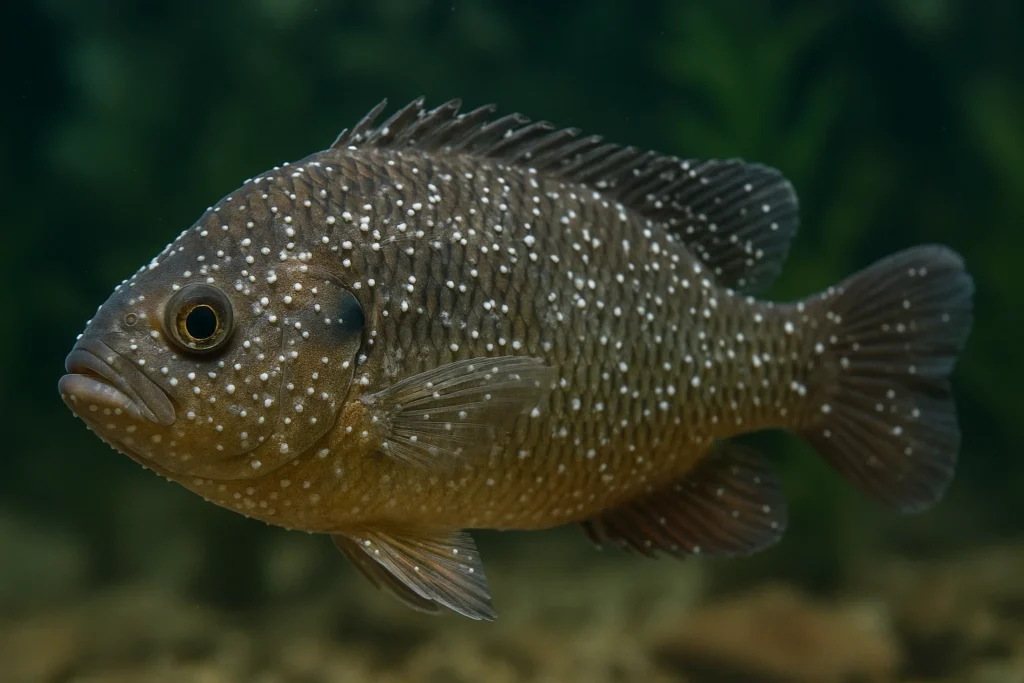
Perhaps the most notorious of all fish ailments, ich (Ichthyophthirius multifiliis) has been the bane of my fish-keeping journey more times than I care to admit. The first time I encountered it, I was caught completely off guard. My vibrant neon tetras suddenly looked like they had been sprinkled with salt, their usually graceful movements replaced by erratic swimming and constant rubbing against decorations.
Symptoms:
- White spots resembling salt grains scattered across the body, fins, and gills
- Scratching or rubbing against tank decorations and substrate
- Clamped fins (fins held close to the body)
- Increased respiratory rate
- Lethargy and loss of appetite
- In severe cases, hiding and isolation from other fish
My Experience: When my community tank experienced an ich outbreak following the addition of some new guppies (lesson learned about quarantine!), I initially panicked. The white spots spread rapidly, and within days, several fish were affected. I raised the tank temperature gradually to 86°F (30°C) while adding aquarium salt—a traditional remedy that proved surprisingly effective for my freshwater community. However, I’ve since learned that medication specifically designed for ich treatment provides more reliable results, especially for sensitive species that can’t tolerate elevated temperatures or salt.
Treatment Options:
- Gradually increase tank temperature to 86°F (30°C) for freshwater fish that can tolerate it
- Commercial ich medications containing malachite green or formalin
- Aquarium salt treatments (1 tablespoon per 5 gallons) for freshwater fish
- Complete the full treatment course even after spots disappear to break the parasite’s lifecycle
Prevention:
- Quarantine all new fish for at least 14 days
- Maintain stable water parameters and regular water changes
- Use a UV sterilizer to reduce free-swimming parasites
- Never add untreated water from other aquariums or fish stores
2. Fin Rot and Tail Rot
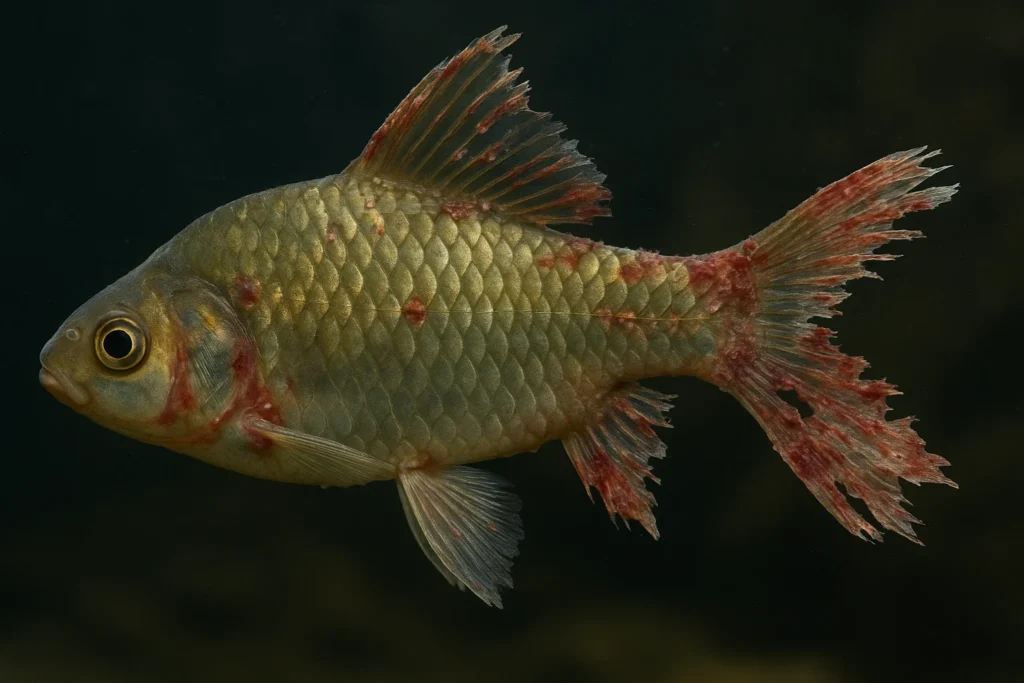
The slow deterioration of once-beautiful fins is both heartbreaking and frustrating. I’ll never forget watching my prized male betta’s flowing tail gradually disintegrate despite my frantic water changes. What I didn’t understand then was that fin rot isn’t just a disease—it’s often a symptom of poor water conditions or ongoing stress.
Symptoms:
- Fins or tail appear ragged, torn, or frayed
- Discoloration along fin edges (white, red, or black)
- Progressive deterioration moving from the edges toward the body
- Inflammation at the base of affected fins
- Lethargy and reduced swimming activity
- Secondary infections may develop on damaged tissue
My Experience: When my betta’s fins started showing signs of deterioration, I initially suspected fin nipping from tank mates. After separating him, however, the condition worsened. Water testing revealed slightly elevated nitrates—not enough to cause alarm for most fish but apparently sufficient to stress my sensitive betta. Aggressive water changes, added Indian almond leaves (which naturally lower pH and have mild antibacterial properties), and meticulous attention to water quality ultimately reversed the damage. The fins grew back gradually over several months, though never quite as magnificent as before.
Treatment Options:
- Immediate improvement of water quality through partial water changes
- Removal of accumulated waste and uneaten food
- Broad-spectrum antibacterial medications for advanced cases
- Addition of tannins (from Indian almond leaves or commercial extracts)
- Salt dips for freshwater fish (separate container with 1 tablespoon per gallon for 5-10 minutes)
Prevention:
- Maintain pristine water quality with regular testing and partial water changes
- Avoid overcrowding the aquarium
- Provide appropriate habitat with hiding places to reduce stress
- Ensure proper nutrition with varied diet
- Address any fin-nipping behavior from aggressive tank mates
3. Columnaris (Cotton Mouth Disease)

Often mistaken for fungal infections due to its cotton-like appearance, columnaris is actually a bacterial disease that can devastate an aquarium with frightening speed. This was the most aggressive pathogen I’ve encountered in my years of fish keeping, capable of claiming entire tanks within days if left untreated.
Symptoms:
- Cotton-like growths or patches, particularly around the mouth, fins, or gills
- Discolored areas that may appear grayish-white or yellow
- Frayed or ragged fins
- Rapid breathing or gasping at the surface
- Lethargy and loss of appetite
- In advanced cases, lesions that develop into open wounds
My Experience: My encounter with columnaris came after adding plants from an established tank without proper disinfection. Within 48 hours, my rainbowfish developed white patches around their mouths and gills. By the time I identified the issue, two fish had already succumbed. I immediately lowered the tank temperature to 75°F (24°C)—contrary to treating most diseases—as columnaris bacteria thrive in warmer water. A combination of water changes and a specific gram-negative antibiotic saved the remaining fish, but the experience taught me a harsh lesson about biosecurity.
Treatment Options:
- Lower water temperature to 75°F (24°C) to slow bacterial growth
- Antibiotics specifically effective against gram-negative bacteria
- Methylene blue baths for affected fish
- Increased aeration as the disease often affects gill function
- Isolation of severely affected individuals
Prevention:
- Quarantine new fish and disinfect plants before adding to established tanks
- Maintain excellent water quality with regular testing
- Avoid overstocking and overfeeding
- Disinfect nets and equipment between tanks
- Promptly remove any dead or dying fish
4. Dropsy
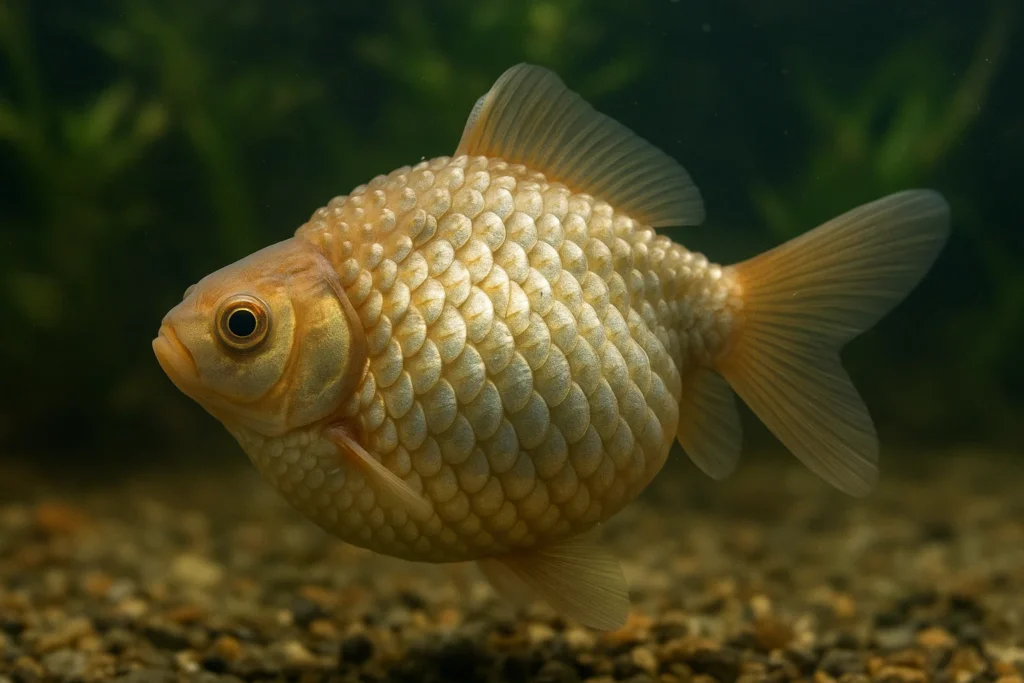
Perhaps the most visually alarming condition, dropsy causes fish to swell dramatically as their scales protrude outward, creating the characteristic “pinecone” appearance. Rather than a disease itself, dropsy is a symptom of severe organ dysfunction, often indicating kidney failure or severe bacterial infection.
Symptoms:
- Bloated, swollen abdomen
- Scales standing outward from the body (pinecone effect)
- Bulging eyes (exophthalmia)
- Pale gills
- Curved spine in severe cases
- Lethargy, loss of appetite, and hiding behavior
My Experience: The first time I encountered dropsy was with an aging goldfish. By the time I noticed the pineconing effect, the condition was already advanced. Despite my best efforts with Epsom salt baths and medicated food, the fish didn’t recover. This experience taught me that dropsy is often the end result of long-term stress or poor conditions rather than an acute infection. Now, I’m vigilant about early signs of bloating or behavioral changes that might indicate developing problems.
Treatment Options:
- Isolation in a hospital tank with pristine water conditions
- Epsom salt baths (1 tablespoon per 5 gallons) to reduce fluid buildup
- Broad-spectrum antibiotics if bacterial infection is suspected
- Medicated food containing antibiotics for internal infections
- Maintaining perfect water quality and optimal temperature
Prevention:
- Regular water testing and changes to prevent buildup of toxins
- High-quality, varied diet to support immune function
- Avoiding overcrowding and overstocking
- Minimizing stress through proper tank setup and compatible tank mates
- Regular observation to detect and address early signs of illness
5. Velvet Disease
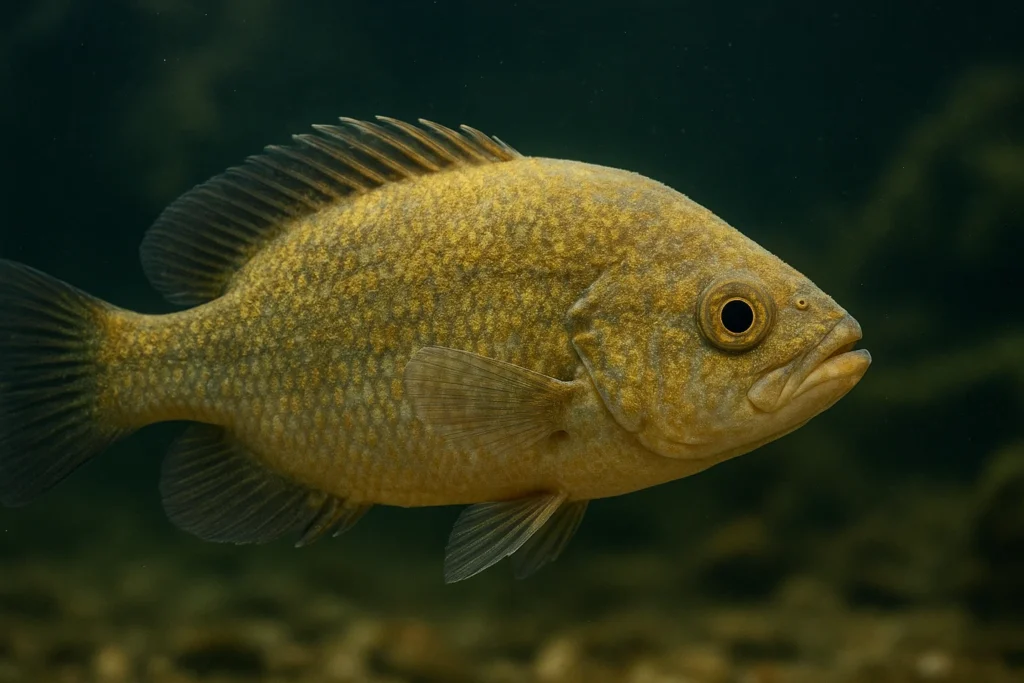
Sometimes called “gold dust disease,” velvet creates a fine, golden or rusty sheen on fish that’s easily overlooked until the infection is severe. Caused by the parasitic dinoflagellate Piscinoodinium, this disease can be particularly challenging to identify in its early stages.
Symptoms:
- Fine gold, rust, or yellow “dust” covering the fish’s body
- Increased mucus production giving fish a slimy appearance
- Rubbing against objects (flashing)
- Rapid or labored breathing
- Clamped fins and decreased activity
- Loss of appetite and weight
My Experience: Velvet entered my aquarium through a batch of live blackworms I fed to my fish—a mistake I won’t repeat. The subtle golden sheen was barely noticeable under normal lighting, but when I shined a flashlight on the tank at an angle during a water change, several fish sparkled unnaturally. Treatment required complete darkness (the parasite needs light for photosynthesis) combined with medication. While most fish recovered, their immune systems remained compromised for months afterward.
Treatment Options:
- Dim or darken the tank completely for several days
- Commercial anti-parasite medications containing copper sulfate (caution: not safe for invertebrates)
- Raising temperature gradually to speed the parasite’s lifecycle
- Salt treatment for freshwater fish (1 tablespoon per 5 gallons)
- Increased water movement to discourage parasite attachment
Prevention:
- Quarantine all new fish for at least 14 days
- Treat all live foods before feeding
- Maintain optimal water parameters
- Use a UV sterilizer to reduce free-swimming parasites
- Disinfect all equipment that moves between tanks
6. Swim Bladder Disorders
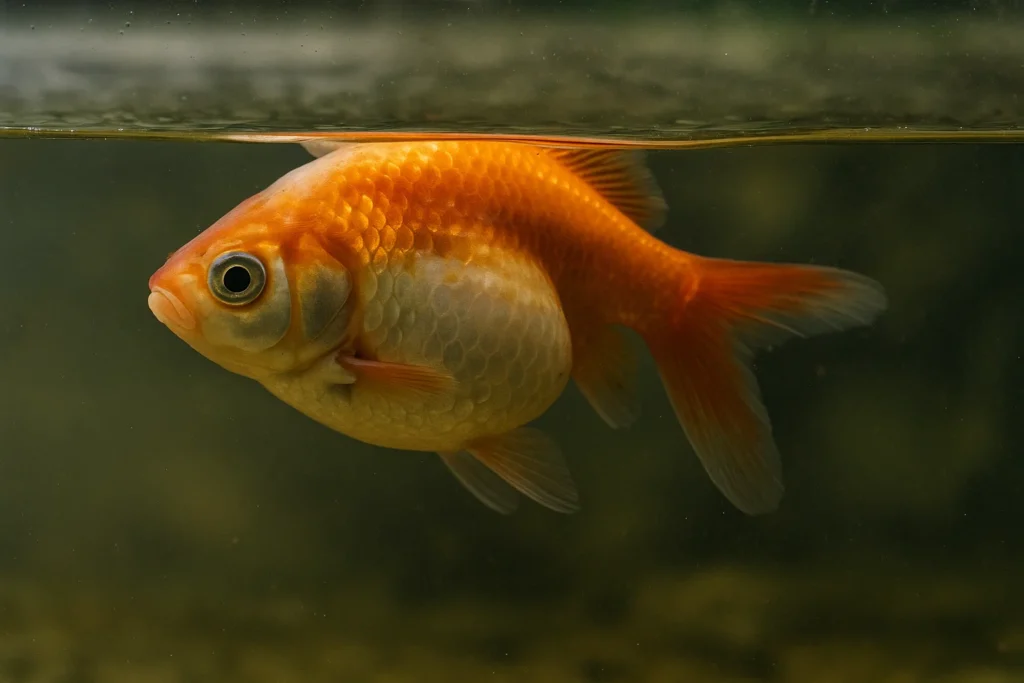
While not contagious like other diseases on this list, swim bladder disorders affect many fish, particularly fancy goldfish and bettas. These conditions impact the fish’s ability to control buoyancy, resulting in difficulty swimming normally.
Symptoms:
- Floating upside down or sideways
- Inability to maintain normal position in the water column
- Struggling to swim to the bottom of the tank
- Sinking and unable to rise from the substrate
- Swimming in circles or other abnormal patterns
- Swollen abdomen in some cases
My Experience: My experience with swim bladder issues primarily involves fancy goldfish—those beautiful but genetically compromised fish with compressed bodies and elaborate fins. One particularly rotund oranda would periodically struggle with buoyancy after feeding, floating awkwardly at the surface. I learned to soak his pellets before feeding and implemented regular fasting days. Most significantly, switching from flake food to sinking pellets dramatically reduced episodes as he no longer gulped air while feeding at the surface.
Treatment Options:
- Fasting for 24-48 hours to clear digestive blockages
- Feeding cooked, shelled peas to help clear the digestive tract
- Adding Epsom salt (1 tablespoon per 5 gallons) to reduce fluid retention
- Raising water temperature slightly to improve digestion
- Feeding specialized foods designed to reduce digestive issues
Prevention:
- Feed high-quality foods and avoid overfeeding
- Soak dry foods before feeding to prevent air ingestion
- Provide properly sized food for the fish species
- Maintain stable water temperature appropriate for the species
- Feed varied diet including fiber-rich options
The Foundation of Prevention: Water Quality Management
Throughout my years of keeping fish, one truth has become abundantly clear: water quality is the foundation of fish health. Nearly every disease outbreak I’ve encountered can be traced back to some form of water quality issue—whether obvious or subtle.
Essential Water Parameters to Monitor:
- Ammonia and Nitrite: These should always read zero in an established tank. Even slight elevations can stress fish immune systems and make them susceptible to disease.
- Nitrate: Keep below 20 ppm for sensitive species, though many hardier fish can tolerate up to 40 ppm. Regular water changes are the best way to control nitrate buildup.
- pH: Stability is more important than the exact number. Sudden pH changes stress fish severely, while most can adapt to a consistent pH outside their ideal range.
- Temperature: Maintain appropriate temperature for your species and avoid fluctuations greater than 2°F within 24 hours. Temperature shocks significantly compromise immune function.
- General Hardness (GH) and Carbonate Hardness (KH): These parameters affect pH stability and osmoregulation in fish. Match water hardness to the needs of your specific species.
My personal prevention routine includes:
- 25% water changes weekly, ensuring the replacement water matches temperature and parameters
- Testing ammonia, nitrite, and nitrate weekly; pH, GH, and KH monthly
- Cleaning filter media in tank water (never tap water) monthly, replacing only when necessary
- Vacuuming substrate during water changes to remove waste and uneaten food
- Maintaining consistent feeding schedule with appropriate portion sizes
Quarantine Procedures: Your First Line of Defense
Perhaps my most valuable lesson came from a devastating ich outbreak that could have been prevented entirely through proper quarantine. New fish, plants, decorations, and even equipment can introduce pathogens to an established tank, potentially leading to fish diseases that could affect all of your aquatic inhabitants.
My current quarantine protocol includes:
- Dedicated Equipment: A separate 10-gallon tank with simple substrate, basic filtration, and minimal decoration makes observation easier and disinfection simpler.
- Observation Period: All new fish spend at least 3 weeks in quarantine—long enough for most common diseases to manifest.
- Prophylactic Treatment: For fish from less reliable sources, I sometimes use mild preventative treatments such as salt or commercially available products designed to eliminate common parasites.
- Monitoring: Daily observation for signs of stress, disease, or unusual behavior gives me the chance to treat problems before introducing them to my display tank.
- Water Quality: Just as important as in main tanks, maintaining perfect water quality during quarantine prevents stress-induced illness.
Nutrition and Immune Support
A well-fed fish is a resilient fish. Throughout my aquarium journey, I’ve observed that fish receiving varied, species-appropriate nutrition consistently show greater resistance to fish diseases than those maintained on a monotonous diet.
Key Nutritional Practices:
- Variety: Alternate between high-quality flakes or pellets, frozen foods, and occasional live foods (properly sourced and treated).
- Species-Specific Needs: Research the natural diet of your particular fish. Herbivores, carnivores, and omnivores have drastically different nutritional requirements.
- Vitamin Supplements: Commercial foods fortified with vitamins or liquid supplements added to frozen foods can boost immune function.
- Feeding Schedule: Most fish benefit from small, frequent feedings rather than one large daily meal. I typically feed adult fish twice daily with an amount they can consume in 2-3 minutes.
- Fasting: A weekly “fasting day” helps prevent digestive issues and mimics natural feeding patterns.
Stress Reduction Strategies
Stress is perhaps the single greatest contributor to disease susceptibility in captive fish. Much like humans who catch colds during periods of stress, fish immune systems become compromised when they experience chronic stressors.
Common Stress Factors and Solutions:
- Incompatible Tank Mates: Research compatibility before combining species. My worst disease outbreaks often followed aggression between mismatched fish.
- Improper Habitat: Provide appropriate hiding places, swimming space, substrate, and water flow for your specific species.
- Overcrowding: Maintain appropriate stocking levels—generally lower than pet store recommendations suggest. I follow the inch-per-gallon rule as a maximum rather than a target.
- Light Management: Provide consistent light cycles that mimic natural conditions, avoiding sudden changes or extended periods of bright light.
- Excess Vibration and Noise: Place tanks away from speakers, doors that slam, or high-traffic areas that cause constant disturbance.
Conclusion: A Holistic Approach to Fish Health
Over my years of fish keeping, I’ve learned that there’s no magic solution that prevents all fish diseases. Instead, successful prevention requires a holistic approach—addressing water quality, nutrition, stress, and quarantine practices simultaneously.
When fish diseases do strike, early identification and prompt, appropriate treatment make the difference between recovery and loss. I’ve learned to keep basic medications on hand and to research proper treatment protocols before emergencies arise.
Most importantly, I’ve come to view fish diseases outbreaks not as random misfortunes but as valuable feedback about my husbandry practices. Each challenge has taught me to refine my approach, creating healthier, more natural environments for my aquatic friends.
Whether you’re a novice aquarist with your first betta or a seasoned hobbyist managing multiple specialized tanks, the principles remain the same: prevention through excellent care, vigilance through regular observation, and intervention at the earliest signs of trouble. With this approach, you’ll not only minimize fish diseases but also experience the profound satisfaction of nurturing thriving underwater ecosystems.
Frequently Asked Questions
1. How can I tell if my fish is sick or just stressed?
Stress and illness often manifest similarly, with symptoms like reduced appetite, color changes, and unusual swimming patterns. However, stressed fish typically improve within 24-48 hours when the stressor is removed, while sick fish continue to deteriorate. Look for physical symptoms like spots, growths, or wounds that indicate disease rather than temporary stress. When in doubt, check your water parameters immediately—poor water quality is often behind both stress and illness.
2. Is it necessary to treat the entire tank if only one fish shows symptoms?
In most cases, yes. By the time one fish shows visible symptoms, the pathogen is likely already present throughout the tank. Treating only the affected fish might save it temporarily, but reinfection upon return to the main tank is likely. Exceptions include non-contagious conditions like physical injuries or genetic swim bladder disorders. When in doubt, treating the entire system is the safer approach.
3. How long should I quarantine new fish before adding them to my main tank?
A minimum quarantine period of 14 days is recommended, but 21-30 days provides greater security. Many common pathogens complete their lifecycle within two weeks, but some can remain dormant longer. During quarantine, maintain optimal conditions and observe for signs of illness. Some experienced aquarists add preventative treatments during quarantine, even for apparently healthy fish.
4. Can plants and decorations transmit diseases to my fish?
Absolutely. Plants, decorations, and even equipment can harbor pathogens, especially parasites with multiple life stages. Always quarantine or disinfect new plants before adding them to established tanks. For decorations, a 10-minute soak in a 1:20 bleach solution followed by thorough rinsing and dechlorination is effective. For plants, a 5-minute potassium permanganate dip or 5-day quarantine is recommended.
5. How often should I be doing water changes to prevent disease?
For most community tanks, weekly water changes of 25-30% provide the best disease prevention. However, heavily stocked tanks may require twice-weekly changes, while lightly stocked, heavily planted tanks might manage with bi-weekly changes. The key is regular testing—keep ammonia and nitrite at zero, with nitrates below 20-40ppm. Consistency is crucial; small, regular water changes are far better than occasional massive ones.

